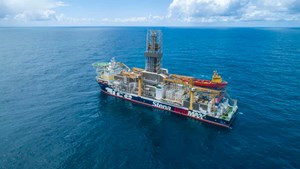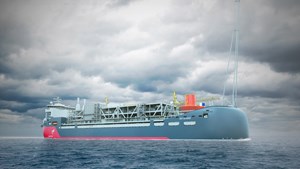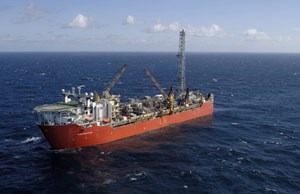Energy NL’s Johnson sees continued improvement in Newfoundland and Labrador’s offshore fortunes
Interview with Energy NL CEO Charlene Johnson
Planned and ongoing E&P activities during 2023 signal what could be the start of a multi-year expansion of projects offshore Newfoundland and Labrador (NL). During her visit to OTC in Houston during early May, Energy NL CEO Charlene Johnson sat down with World Oil Editor-in-Chief Kurt Abraham to give her assessment of where the sector stands. Some of the following content has since been updated to reflect recent changes in project status.
World Oil (WO): Please give us an assessment of how things are going overall in the NL offshore sector.
Charlene Johnson (CJ): I think there's a positive vibe. ExxonMobil's Gale well, which is in the Jeanne d'Arc basin, is highly anticipated this summer. I think this is the first time in maybe a couple of years that there's been exploratory drilling in the Jeanne d'Arc basin, so it's great to see that. This is in the northern part of the Jeanne d'Arc basin, the West Hercules (semisubmersible) will drill that well, and there is lots of excitement. I mean, ExxonMobil has been around for a long time in our offshore. We just celebrated 25 years of first oil at Hibernia field, back in November. So, it's great to see they're drilling this year, and great to see that it's in two different potential fields. Diversity of play is good.
In terms of development, my understanding is that conversations were still continuing between the province and Equinor for the benefits agreement for the Bay du Nord field development, right up to when Equinor announced the postponement of the project on May 31. Of course, we were disappointed that Equinor chose to delay the development for up to three years, however, we have been here before, and we will continue to work toward making a positive case for the project. Disappointment very quickly turned to resolve, and we have confidence in the project and the people working to make it a reality.
From a subsea perspective, Bay du Nord is a massive project. And also from an environmental perspective, it's one of the lowest carbon projects per barrel of oil in North America. Likely one of the lowest in the world. So, as long as the world needs oil, it should come from places where it's lower- carbon, and companies are focusing on ESG, which Canada does in spades.
In terms of the seismic program announced in the budget, we were elated with that. We've been advocating to have that program return, and to the (provincial) Premier's credit, and to the Minister's credit, they did say it would be put on pause, and then they announced $13 million in the budget for it again this year. So, that's really important, both from having the information to attract companies during our bid round, and also in terms of the message that it sends for our oil industry. So, it's great to see the return of that program.

WO: Wind and hydrogen seem to be becoming more important to the NL energy sector. Can you offer any details on these efforts?
CJ: We have a lot happening on the wind energy front, wind-hydrogen front. There's regulations being developed for preparing for the bid round for offshore wind. So, the CNLOPB is targeting 2025, for the first bid round for offshore wind projects. And then there's a lot happening with onshore wind projects, which will mainly be exporting hydrogen to Europe. There’s 19 companies that have applications in now for onshore wind projects. But it just goes to show, in terms of energy, it's not either or. And Newfoundland and Labrador is so perfectly positioned in all forms of energy. And, you know, strategically in terms of geography, our wind, it's very windy there, as you can probably attest to, when you've been there and, it's consistent when you look at other places in North America, our wind blows consistently 40% of the time, compared to 30% of the time in other parts of North America. So, it makes our jurisdiction attractive in that way, as well.
WO: The return of the provincial seismic project will increase the demand for vessels, and it may also have a CCUS angle; is that right?
CJ: A lot of these offshore seismic vessels are seeing greater demand for their services, because a lot of jurisdictions around the world have returned to seismic work. So, it's a real competition to get these vessels. It’s a real challenge right now. Meanwhile, some of the old seismic data has been reviewed to look at the potential for CCUS. So, it's repurposing some of that old data. In terms of the potential, early estimates show that we can store the equivalent of all of Canada's greenhouse gas emissions offshore. So, there is an RFP out, right now, to look at that storage potential and firm that up and look at the reservoirs and the permeability and the porosity, and all those sorts of things. It holds a lot of potential for one, from an environmental perspective to store all the carbon, and two from a work perspective for our members.

WO: Let's shift gears and talk a little more about the exploratory drilling and its impact on the province.
CJ: Each exploration well brings about the equivalent of 400 jobs for Newfoundland and Labrador, and there's more outside the province. It’s really important to have those jobs, but ideally, we want a discovery. That’s because when you get to the development and production phase, then it's about 4,500 jobs, compared to 400. But remember, it's the second step. The first step is seismic, as you know, and then exploration drilling is the second step. It's just really good to see companies reinvesting again in exploration. Many jurisdictions slowed down during the pandemic. So, when we talk about each exploration well representing 400 jobs, that's workers on the rigs, helicopters transporting people, supply vessels, health, life, safety, fire, catering. The multiplier effect of a well like this is one of the largest in this industry.
WO: As regards next year, hopefully there will be some additional exploratory wells, correct?
CJ: Well, we wouldn't know that quite yet, although we remain very hopeful. I don't think any well has actually been confirmed for drilling next year, at least not officially. There's been some talk, but nothing official that we can really discuss.
WO: Obviously, work is continuing on the West White Rose field development, including the actual platform.
CJ: Oh, yes, they had about 1,700 people on site as of May, so that's moving along. The operator, Cenovus, is also planning a retrofit for their FPSO asset life extension. So, they'll be looking for a dry dock. And back in November,. we had the bid round. So, there were five bids made, totaling a quarter of a million dollars. It's good to see that level of activity again---BP, Equinor, Exxon. Some doing it alone, some partnering.
WO: In addition to West White Rose, there is additional field work going on. What can you tell us about that?
CJ: There certainly is ongoing work at the Terra Nova field. The FPSO came back from Spain in February after undergoing roughly $500 million of repairs. It's currently in the Bull Arm facility in Newfoundland and Labrador and needs some additional work before it can go back into production. So, I don't have details on how long or how many people are involved, but, fair to say, it's a significant piece of work. While this further delay is unfortunate, it also brings employment, so I guess you have to find the good in the bad wherever you can. Suncor is not giving a timeline as to when they think it will be back in production. Hopefully it’s 2023 at some point.

WO: Can you tell us anything about the natural gas assessment that is funded in the latest provincial budget?
CJ: In the budget, there is $5 million for natural gas assessment in the Jeanne d'Arc basin. I think that's important, because there's a company called LNG NL and they're looking at developing gas in the basin, so this will help to do a good evaluation of the resource assessment there. Also, through our net zero project, we hired Aker to do some work on blue hydrogen. Those results were released at our conference, and there are some potential opportunities on that front.
FROM THE ARCHIVE- Applying ultra-deep LWD resistivity technology successfully in a SAGD operation (May 2019)
- Adoption of wireless intelligent completions advances (May 2019)
- Majors double down as takeaway crunch eases (April 2019)
- What’s new in well logging and formation evaluation (April 2019)
- Qualification of a 20,000-psi subsea BOP: A collaborative approach (February 2019)
- ConocoPhillips’ Greg Leveille sees rapid trajectory of technical advancement continuing (February 2019)



